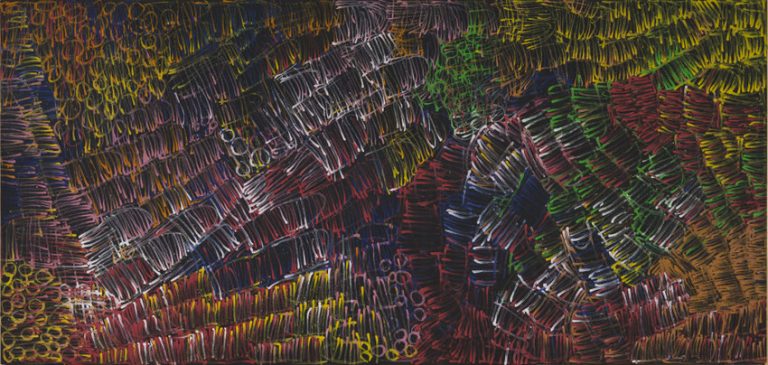We acknowledge the Traditional Owners of the land on which the Queensland Art Gallery | Gallery of Modern Art stands and recognise the creative contribution First Australians make to the art and culture of this country.

Minnie Pwerle / Anmatyerre/Alyawarre people / Australia b.c.1910-2006 / Awelye Atnwengerrp (Women’s ceremony from the Atnwengerrp) 2000 / Synthetic polymer paint on cotton canvas / 165.8 x 348cm / Purchased 2003. Queensland Art Gallery Foundation / Collection: Queensland Art Gallery | Gallery of Modern Art / © Minnie Pwerle
Minnie PwerleAwelye atnwengerrp (Women’s ceremony from the Atnwengerrp) 2000
Not Currently on Display
Minnie Pwerle’s painting depicts an imagined ceremonial scene, including the designs painted on the upper body during women’s ceremony in Atnwengerrp, a region near the Sandover River, north of Utopia in the Northern Territory.
These ceremonies celebrate bush food: in this important painting, the bush melon — Pwerle’s totem — is represented by the twisting, winding designs created with brushstrokes to make rhythmic, circular patterns.
The bush melon was once an abundant fruit for Atnwengerrp but is now hard to find. Minnie Pwerle and other local women used to collect it and scrape out the small black seeds. It could be eaten immediately or cut it into pieces, skewered and dried, for occasions when bush tucker was scarce. Pwerle’s Dreaming concerns the bush melon and its seeds. Her depiction of this fruit, and related ceremony, is a reflection of her love and respect for country.
Minnie Pwerle was born in the Utopia region, approximately 270 kilometres north-east of Alice Springs, in the Northern Territory. In 1999, then in her late eighties, Pwerle began painting on canvas after taking part in workshops conducted by her grandson, Fred Torres, in Adelaide.
She remained a prolific painter until her death in 2006, using bold, expressive brushwork like that of her famous sister-in-law, Emily Kame Kngwarreye, and other important Utopian artists Kathleen Petyarre, Gloria Petyarre, and daughter Barbara Weir.
Initially Pwerle’s principal artistic expression was through the application of body paint to participants in women’s ceremonies. By sharing stories on canvas, she has preserved them for the future.
Discussion Questions
1. Describe Minnie Pwerle’s relationship to colour as the custodian of the bush melon.
2. The important role of women in the desert community of Utopia is not only evident in the artistic success of Pwerle, her sister-in-law Emily Kame Kngwarreye and others, but also in their knowledge of bush food and bush medicine. Discuss the unique knowledge and skills of the women in your family.
Classroom Activities
Research ‘bush tucker’ local to your area. Create an abstract painting using the colours and patterns of the bush tucker foods that you discover.